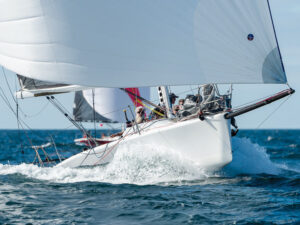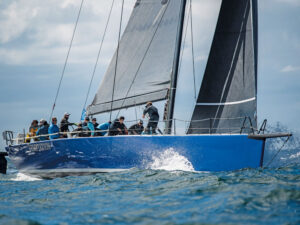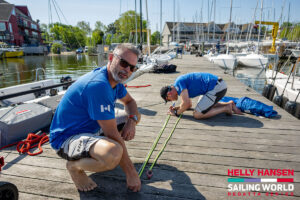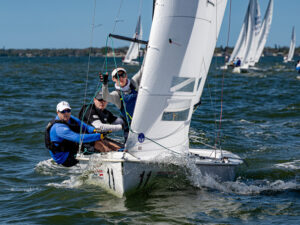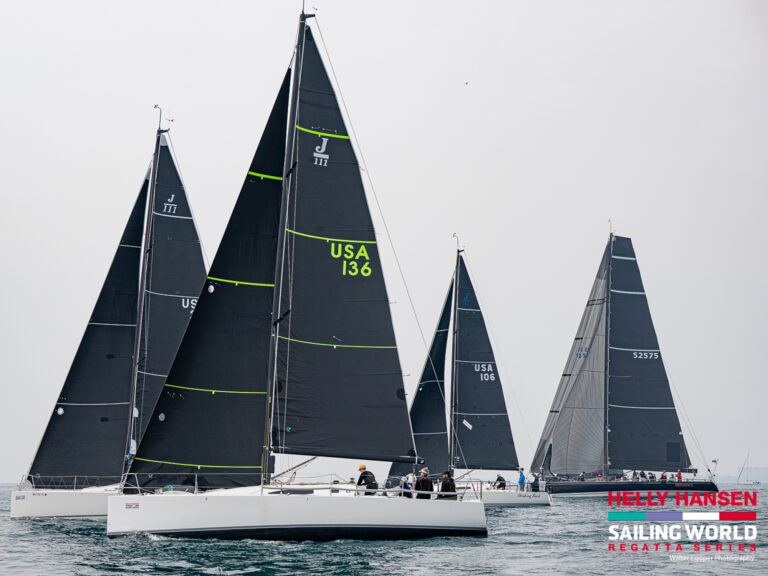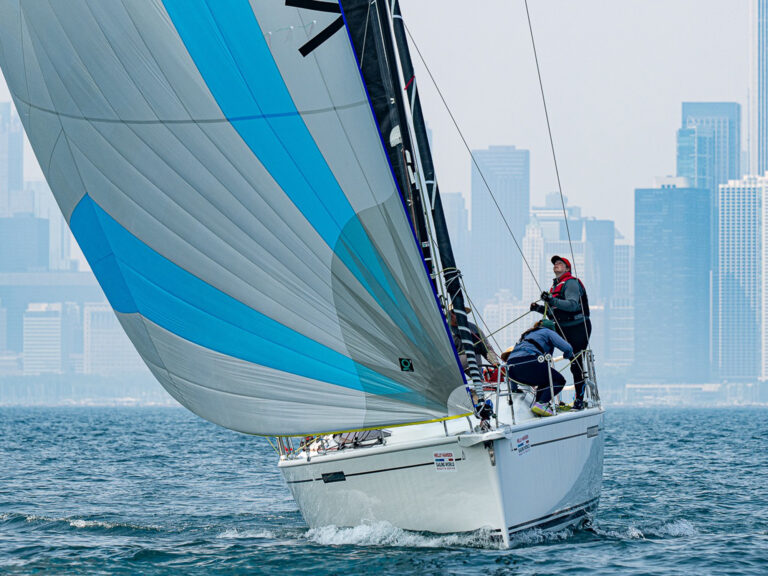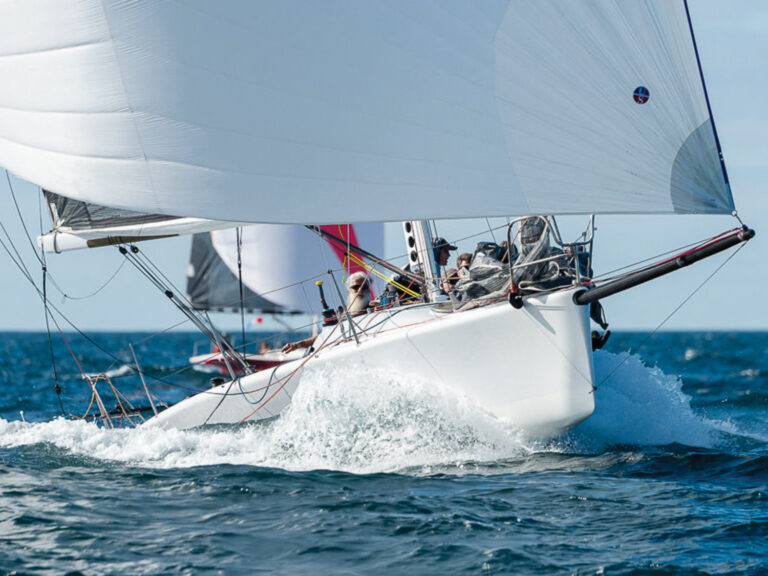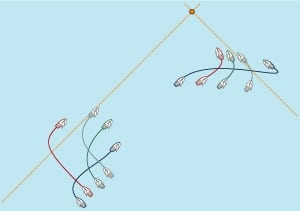
As you approach the weather mark in a crowd and sail in a progressively smaller cone of water, finding a clear lane becomes more difficult. It’s important to know what boats are ahead of you, anticipate their next moves, and react accordingly. Doing so will allow you to sail in clear air for as long as possible while sticking close to your overall leg strategy. Here are tactics for dealing with situations you may encounter at the top of the beat.
Just behind, approaching a long layline
You’re just behind a pack of boats as you approach a long port or starboard layline. In this situation, tacking on the layline will result in a lot of time spent sailing in bad air. It may also force you to overstand in an effort to find clear air. Both scenarios will cost you boats. You can avoid this by tacking before the layline. The tricky part, however, is choosing exactly when to tack.
It’s likely that you, as well as the boats around you, are sailing towards the layline because it’s the correct way to go. Maybe you’re waiting for a shift or sailing toward a puff. If so, you may have to tack early to avoid the layline and stay in clear air. To avoid tacking any sooner than you need to, anticipate when the boats in front of you will tack. How early you need to tack depends on how many boats are ahead. You don’t want to give up any more than is necessary with regard to the shift or puff. Keep in mind that everyone else will be trying to stay in clear air as well.
International 505 champion Peter Alarie explains this concept by thinking of clear lanes as numbered in order of desirability. The lead boat is going to take lane No. 1. The number one lane may be right on the shift or on the layline. To keep its air clear, the second boat will take lane No. 2, to leeward of No. 1. The third boat will take No. 3 and so it goes down the line for all the boats that are close enough to affect your air. If you’re in fourth position, you can’t tack in lane No. 3. If you try, you’ll end up in bad air.
There’s often an opportunity to be the “vulture.” If you’re in fifth position and you see the fourth boat sail past lane No. 4, then it’s yours. The fourth boat will end up overstanding or sailing in bad air. If this is the case, you will most likely pass them on the next crossing even though you sacrificed some of the shift or puff.
Make sure you consider how much you’ll give up strategically and weigh it against the gains you’ll make by sailing in clear air. Occasionally it pays to spend some time in bad air in order to get to a good spot on the racecourse.
Just behind, approaching a short starboard layline
Imagine yourself behind a pack of boats, approaching a short layline. This is similar to the previous example except that you’re closer to the mark. When approaching the port layline, it’s usually best to tack out early any time you’re not leading, especially when you’re in a pack of boats.
Approaching a short starboard layline is a common scenario. If the group in front of you is tightly packed, consider overstanding. As the lead boats tack on the layline, boats approaching on port will be tempted to leebow rather than duck a long line of starboard tackers. A boat that successfully leebows outside the two-length zone may have to pinch in order to make the mark, forcing the boats to weather to also pinch. The result can be a large group of boats all sailing slowly towards the mark. An extreme case of this can result in a pile up at the weather mark.
In these cases, you can make a big gain by coming in above layline at full speed and sailing around the pack while your competitors luff each other at the mark. How much you need to overstand will depend on the boats in front of you. You may need to overstand slightly more than a boat ahead of you trying to do the same thing. There’s a point of diminishing returns. If a lot of boats in front of you overstand, you’ll have to overstand too much in order to have clear air. In this case, it’s better to slightly overstand and sail in bad air. Tacking below the pack should be avoided. If you’re close to the mark this is likely to force you to the port layline and ultimately present you with a wall of starboard tack boats on the layline.
Just ahead, on the port layline
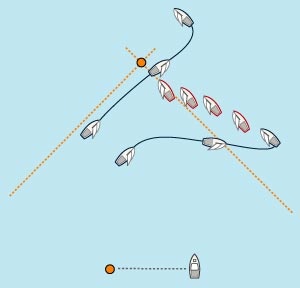
Sometimes you can’t avoid approaching the mark on the port layline. If you’re not crossing boats on the starboard layline, you have to duck them to avoid fouling. If you’re crossing, be careful not to break Rules 13 or 18.3. Be sure to completely cross starboard-tack boats before you start your tack. You’ll probably round after the boat you crossed, but that’s better than doing a 720.
Just ahead, approaching a short starboard layline
If you’re ahead approaching a short starboard layline, you’re in good shape but not quite out of the woods. It’s important to tack right on the layline. By nailing the layline you force your competitors to either leebow—and risk not making the mark—or duck. Since you would much rather have your competitors duck, it’s good to give them a little encouragement.
If it looks as if they’re going to try a lee bow, bear off a little bit. One of two things will happen. A savvy competitor will realize that you’re about to force them to tack below layline, and decide to duck you. A less experienced sailor will be forced to tack sooner than expected and probably botch the lee bow. In this situation, you should be able to use the extra speed generated by footing to pinch up and make the mark. Be careful not to overdo it. You don’t want to foul (breaking Rule 16.2) and you still want to get around the mark without having to tack.
All of these situations call for a good deal of anticipation. Ask yourself, “what would I do if I were in their position?” If they behave as you anticipate, you’ll have had plenty of time to plan your move in response. If they do something you don’t expect, it means they’ve probably made a mistake. This means you’ll have an opportunity to take the better lane and make a gain before you round the weather mark.

